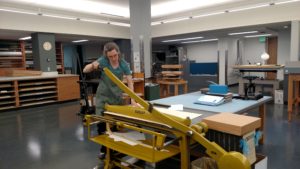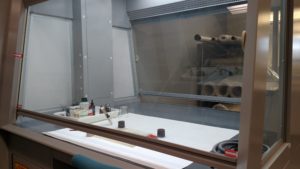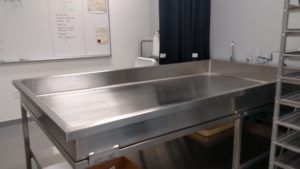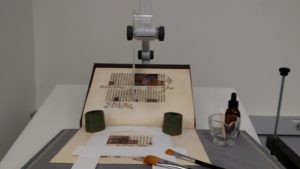Benjamin Franklin wrote his own epitaph as a youth while working as a printer’s “devil” (apprentice.) We’ve paid homage to this clever metaphor before, but it is worth repeating.
The Body of
B. Franklin, Printer;
Like the Cover of an old Book,
Its Contents torn out,
And stript of its Lettering and Gilding,
Lies here, Food for Worms.
But the Work shall not be wholly lost:
For it will, as he believ’d, appear once more,
In a new & more perfect Edition,
Corrected and amended
By the Author.
Franklin understood the fragility of the printed word. For as long as men and women have created books, they have looked for ways to preserve them. In many cases, clumsy efforts to “fix” a book, manuscript, or document do more harm than good. However, in the right hands and with the right tools, items damaged by water, mold, vermin, or simple age can be restored to a near perfect edition.
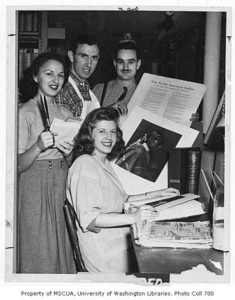
Staff of the library’s repair unit, or “bindery,” display samples of their work, 1940. A sense of cramped quarters is apparent. Photo courtesy of University of Washington Libraries, Special Collections, UW19967z
Seattle’s University of Washington is the custodian of a century and a half of collected materials housed in 16 libraries, including nine million printed volumes. Since the 1920s the school has had a repair unit for books and manuscripts housed within its main Suzzallo Library. In the early 1960s several small workstations were combined into a formal conservation lab within two windowless basement rooms.
The U Dub is also recognized for its Book Arts Collection, housed within the Special Collections unit of the library system: 21,000 historical and modern pieces which demonstrate the art of printing, bookbinding, illustration, and typography.
Several years ago the University libraries laid plans to insure best practices in preservation work by designing a state-of-the-art conservation lab on the fifth floor of the venerable Suzzallo library. To complement this effort, in 2012 the University applied for, and received, a $1.25 million challenge grant from the Andrew W. Mellon Foundation to establish an endowment with the goals of funding a Senior Conservator position and a summer student internship in perpetuity.
In 2013 Justin Johnson, formerly Book Conservator at the Huntington Library in California, was hired to fill the position of Senior Conservator, Preservation Services. Johnson joined a team of some nine archival specialists and interns. One of Johnson’s first major projects was the conservation of an important and rare book: Sir Walter Raleigh’s History of the World from 1614.
At an open house held at the lab in June of this year, UW Book Arts Curator Sandra Kroupa described the work of conservation as equal parts art, craft, and science. A tour of the lab bears out this assertion as the visitor views both age-old machinery and high-tech equipment, as well as staff working painstakingly with brushes, glues, needle and thread.
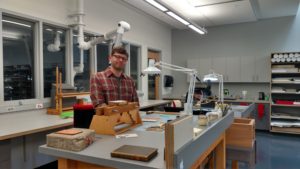
Justin Johnson, the library’s Senior Conservator, is at one of several work stations in the lab’s 4,000 square feet. The new facility is twice the size of the old lab.
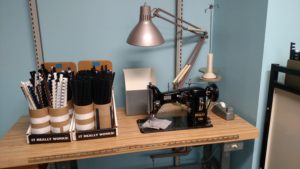
A vintage Pfaff sewing machine still does service in stitching polyester sleeves for outsized documents and panoramic photographs. The Pfaff model 130 was introduced in 1932 and was manufactured into the 1950s.
Kate Leonard explains that sewing can bind diverse materials such as polyester and buffered card stock more efficiently than adhesives. Sewing does not age!

The lab possesses a Chandler & Price Company “guillotine,” a word commonly used in the industry for machines that cut pasteboard and trim books. The Cleveland-based company was best known for manufacturing jobbing presses.
Several pieces of modern equipment sit in the aqueous treatment room, or wet room, a ventilated environment that allows conservators to isolate the effects of noxious fumes, light bleaching, and spills resulting from wet treatments.
Though it may seem counterintuitive, paper can be washed to aid in removal of adhesives, stains, and acids. It may also help flatten stiff or brittle paper. A large stainless steel sink in the aqueous treatment room is reserved for clean water treatment only. Separate sinks are available for cleaning materials containing solvents and chemicals.
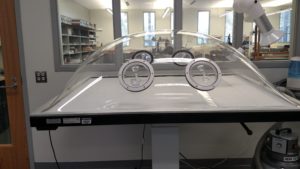
A humidification dome allows materials to be processed with regulated moisture, such as may be required for flattening brittle papers. The dome sits atop a suction table which allows the conservator to force solvents into the paper.

Intern Sarah Belasco meticulously repairs a small leather-bound book. A Kwikprint hot stamping machine stands in the background.
The work of the lab makes fragile materials available again to scholars of all stripes, assisting the University to fulfill its mission to “advance intellectual discovery and enrich the quality of life by connecting people with knowledge.”
❧
ABM Guest Blogger Eleanor Boba is a public historian who blogs about historic places off the beaten path and other curious matters. She lives in Seattle.



